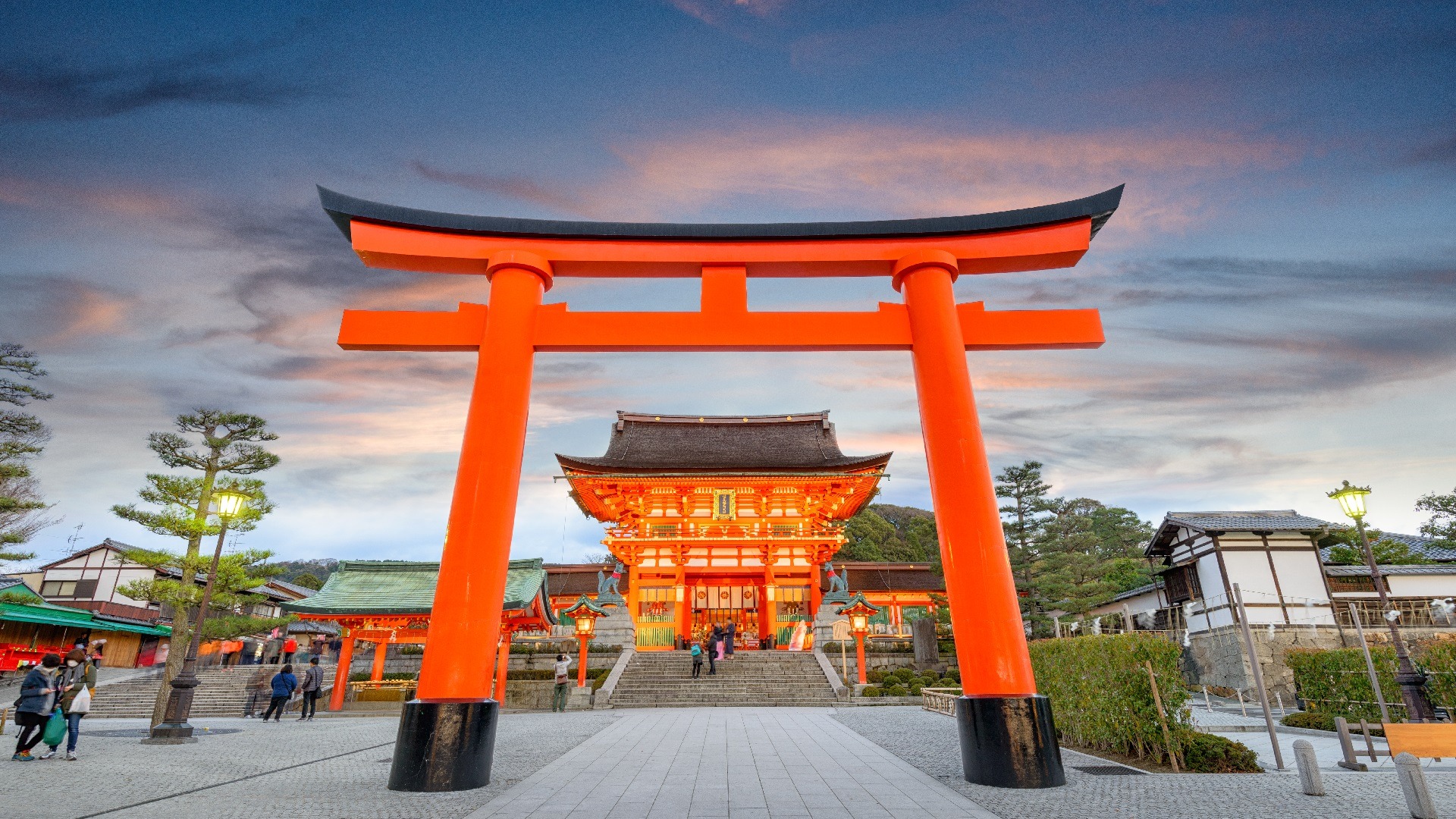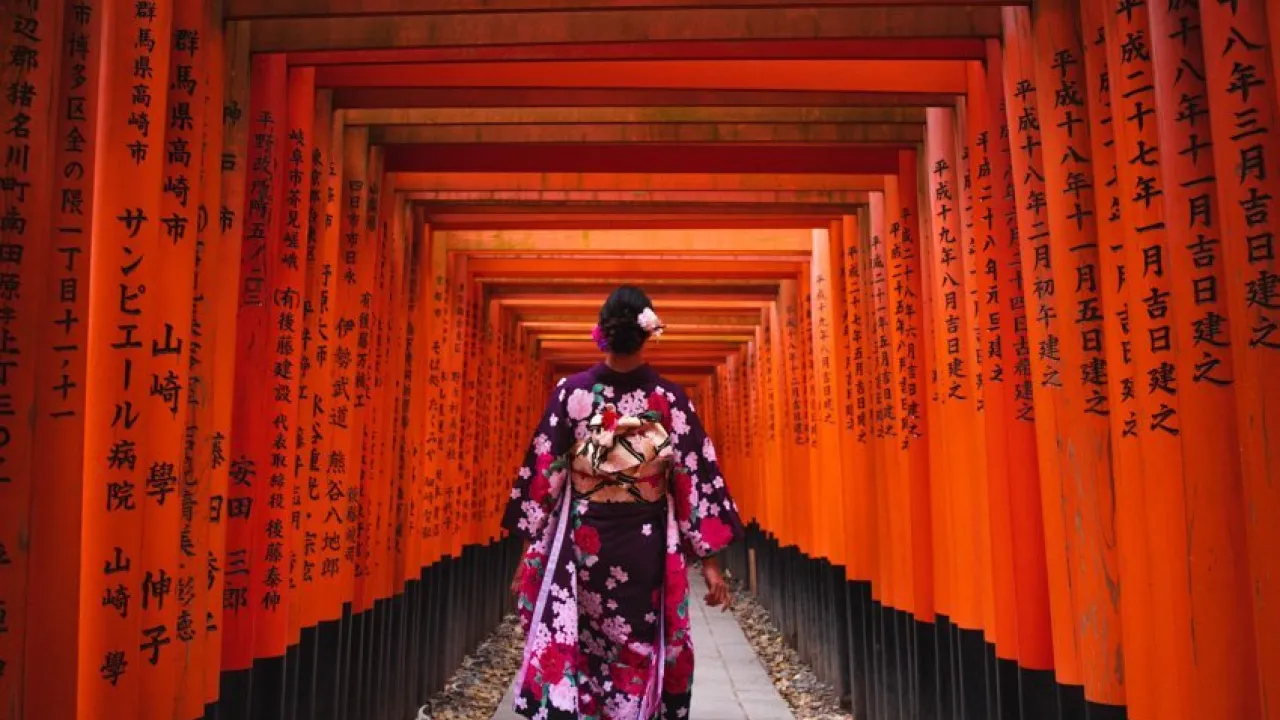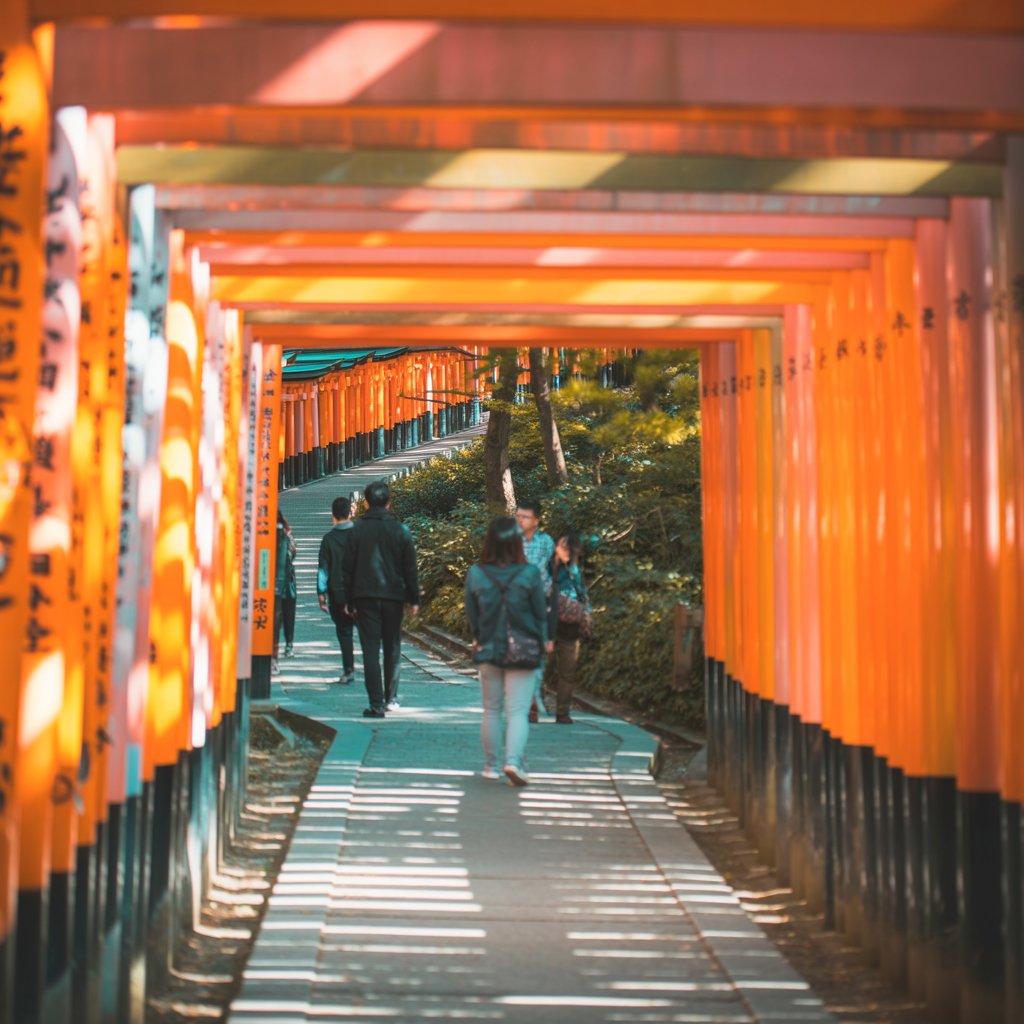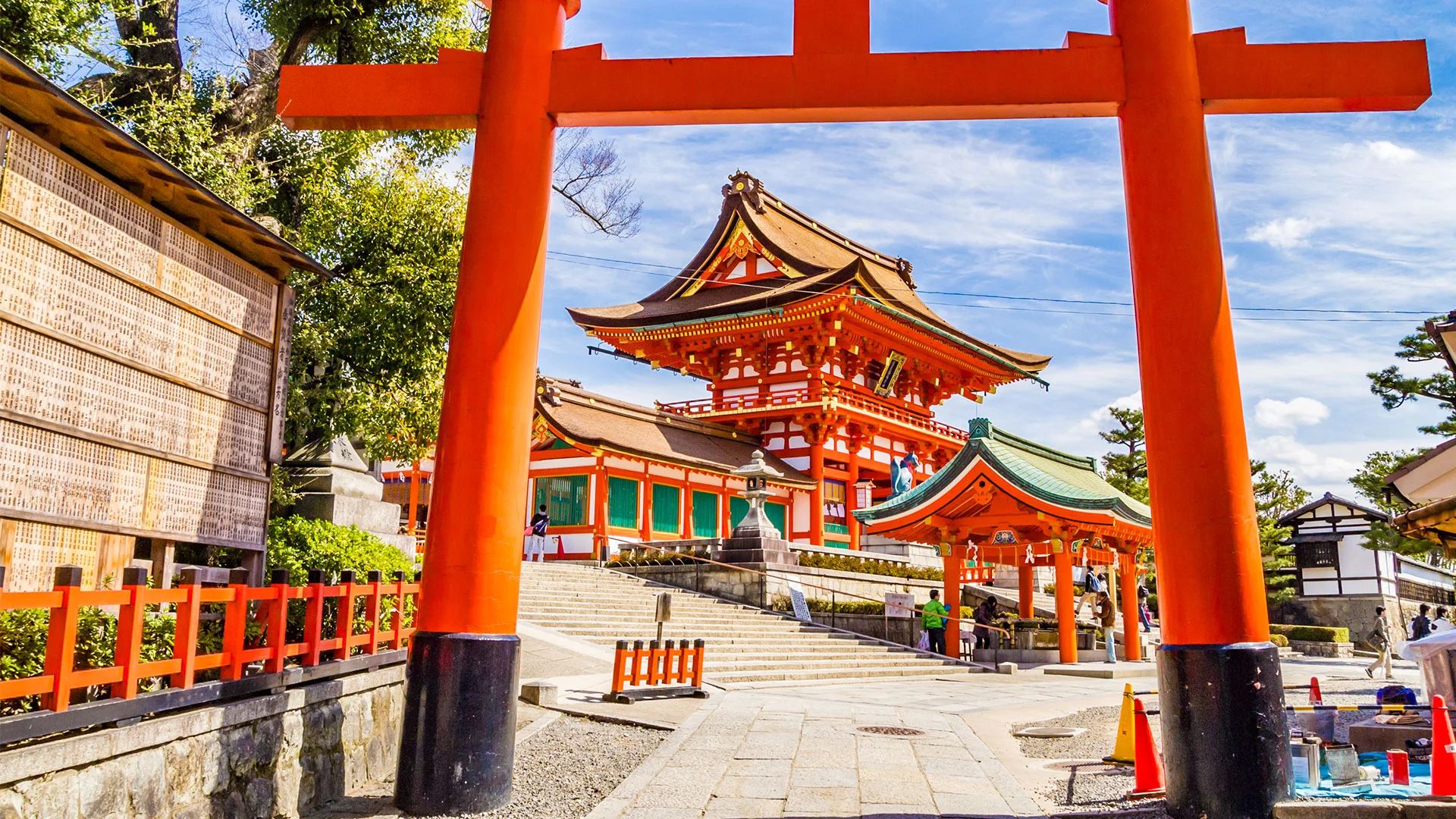Nestled at the base of Kyoto’s Mount Inari, Fushimi Inari Taisha is more than just a place of worship—it’s a breathtaking fusion of spirituality, tradition, and nature. Revered for centuries and visited by millions, this shrine holds a timeless charm that places it firmly among the Best Temple in Japan. One of the most captivating features that defines the Fushimi Inari experience is the mesmerizing Senbon Torii, or the “thousand torii gates.”
The Iconic Senbon Torii: A Pathway to the Divine
Imagine stepping into a world where every footstep carries a wish, a prayer, or a thank-you. That’s exactly what it feels like to walk through the Senbon Torii—an awe-inspiring corridor of over 10,000 vibrant vermilion gates.
Each gate has been donated by individuals or businesses over the centuries as a gesture of gratitude or a prayer for good fortune. As you wander through this fiery tunnel that winds up the mountainside, the outside world seems to melt away. You’re left with the sound of your footsteps, the whisper of rustling leaves, and a sense of peace that’s hard to find elsewhere.
A Living Symbol of Hope and Prosperity
These torii gates aren’t just beautiful—they’re deeply symbolic. In Shinto tradition, a torii marks the transition from the mundane to the sacred. Walking through them is believed to cleanse the spirit and bring you closer to divine protection. Locals and travelers alike often come here to seek blessings for business success, family health, or personal happiness.
Nature’s Contrast: Vermilion Against Green
What makes the experience even more magical is the striking contrast between the rich red gates and the lush green forest surrounding them. Especially during early mornings or at twilight, the light filters through the gates and trees in a way that feels almost otherworldly. It’s no wonder photographers, artists, and spiritual seekers are drawn to this site again and again.
A Journey, Not Just a Visit
Walking the entire torii path can take up to two hours, but every step feels meaningful. Small shrines, stone foxes, and scenic viewpoints along the way encourage you to pause, reflect, and appreciate the moment. It’s not just a tourist attraction—it’s a meditative journey.
Fushimi Inari Taisha isn’t just one of the Best Temple in Japan because of its beauty. It’s beloved because it offers something deeper: a personal, emotional connection that lingers long after you’ve left the last torii gate behind.

Spiritual Significance as the Head Inari Shrine
Step into Fushimi Inari Taisha, and you’re entering the spiritual heart of a vast network of belief and tradition that stretches across all of Japan. Established in 711 AD, this iconic shrine isn’t just famous for its stunning torii gates—it holds profound importance as the head shrine of over 30,000 Inari shrines nationwide.
Inari: The Guardian of Prosperity
At the core of this shrine’s spiritual energy is Inari Ōkami, the Shinto deity of rice, agriculture, fertility, industry, and success in business. In ancient times, rice wasn’t just food—it was the very lifeblood of Japanese society. A bountiful harvest meant prosperity and survival, and Inari was believed to hold the key to it all.
Over the centuries, as Japan evolved from a farming society into a nation of commerce and innovation, Inari’s blessings expanded to include business and financial success. Today, both farmers and CEOs bow their heads in the same sacred space, seeking guidance and good fortune.
A National Network of Faith
It’s hard to grasp the full weight of Fushimi Inari’s spiritual authority until you realize that more than 30,000 sub-shrines across Japan look to it as their source. Whether you’re in a quiet rural village or a bustling Tokyo district, chances are an Inari shrine is nearby—each one echoing the prayers that begin right here in Kyoto.
A Place Where Faith Feels Personal
For locals, Fushimi Inari isn’t just a place to visit on holidays—it’s a sacred ground where personal milestones are marked. Business owners come before launching new ventures. Families offer prayers for good health and abundance. Students pray for exam success. The connection is deeply personal, and you can feel it in the quiet reverence with which people approach the main altar.
Read More Blogs: Adi Kailash Yatra 2025: Sacred Himalayan Pilgrimage
A Spiritual Anchor Among the Best Temple in Japan
What makes Fushimi Inari Taisha truly one of the Best Temple in Japan is not just its architectural beauty or fame—it’s the living, breathing faith that pulses through its grounds. It’s a place where ancient belief meets modern hope, where centuries-old traditions continue to guide lives today.
Rich Historical Legacy That Spans Over a Millennium
Fushimi Inari Taisha isn’t just steeped in myth—it’s carved into the very fabric of Japan’s history. With its origins dating back to 711 AD, this sacred site has witnessed the rise and fall of empires, the evolution of Japanese society, and the unbroken continuity of spiritual tradition. Its resilience and relevance over the centuries are part of what makes it one of the Best Temple in Japan.
A Shrine Touched by History’s Greatest Figures
One of the most notable moments in Fushimi Inari’s long legacy came in 1589 when Toyotomi Hideyoshi, one of Japan’s great unifiers, made a significant donation: the Romon Gate. This towering structure at the entrance of the shrine still stands today, welcoming visitors with the same sense of grandeur and reverence as it did over four centuries ago.
Hideyoshi’s devotion wasn’t just political—it was deeply personal. He dedicated the gate in prayer for his mother’s recovery, a testament to how even the most powerful leaders turned to Fushimi Inari in times of need.
A Timeline of Living Tradition
Through wars, natural disasters, and cultural shifts, Fushimi Inari has remained a spiritual constant. While modern buildings rise and fall around Kyoto, the shrine’s torii paths and fox statues continue to tell stories of devotion, gratitude, and hope. Its architecture has evolved gracefully, preserving classic elements while absorbing influences from different historical eras.
A Cultural Treasure Passed Through Generations
Visiting Fushimi Inari today isn’t just about sightseeing—it’s about time-traveling. You walk the same paths that samurai once walked, pass under gates placed centuries ago, and take part in rituals unchanged for generations. Each prayer offered, each incense lit, connects you with the countless souls who stood in the same place, with the same hopes.
Among the Best Temple in Japan for Good Reason
This rich tapestry of history gives Fushimi Inari a depth that few sites can match. It’s not just a historical landmark—it’s a living monument to Japan’s spiritual journey. And that’s exactly why it remains one of the Best Temple in Japan—where past and present exist in powerful harmony.
The Majestic Romon Gate: A Grand Welcome to the Sacred
As you approach Fushimi Inari Taisha, one feature immediately commands your attention—the Romon Gate, standing tall and proud like a timeless guardian. This towering two-story gate marks the threshold between the everyday world and the sacred space beyond, and it’s nothing short of breathtaking.
A Gift of Devotion From Toyotomi Hideyoshi
This architectural marvel was gifted to the shrine in 1589 by none other than Toyotomi Hideyoshi, one of Japan’s most revered historical figures. His offering wasn’t merely
political; it was profoundly personal—a prayer for his ailing mother’s recovery. That depth of emotion, of human connection, is infused in every beam and detail of the Romon Gate.
An Icon of Traditional Japanese Architecture
Romon literally means “two-story gate,” and this one is a perfect example of Momoyama-era craftsmanship. With its sweeping eaves, intricate woodwork, and vermilion hues, the gate is both bold and serene. It’s not just a structure—it’s a statement. One that says, you’re about to enter a place of reverence, tradition, and wonder.
For many visitors, passing under the Romon is a moment of reflection. It’s where you leave behind the noise of modern life and step into something eternal.
Setting the Tone for a Spiritual Journey
Every great journey begins with a powerful first step, and the Romon Gate provides exactly that. It doesn’t just serve a functional purpose—it sets the tone. Visitors often pause here, not just for photos, but to breathe deeply and ready their hearts for the path ahead. Whether it’s your first visit or your tenth, this gate always feels like a beginning.
A Landmark Among the Best Temple in Japan
It’s features like the Romon Gate that elevate Fushimi Inari Taisha beyond beauty and into the realm of cultural and spiritual majesty. This gate isn’t just admired—it’s remembered. And that’s why Fushimi Inari continues to be celebrated as one of the Best Temple in Japan—where every architectural element carries meaning, memory, and magic.
Read More Blogs: 10 Best Hotels Close to Iceland’s Blue Lagoon Spa in 2025

One of the most unique features that sets Fushimi Inari Taisha apart from other sacred sites—and a key reason it ranks among the Best Temple in Japan—is its enchanting Mount Inari hiking trail. This isn’t just a stroll through temple grounds; it’s a 4-kilometer pilgrimage that weaves through lush forests, hidden shrines, and deeply spiritual landmarks.
A Serene Path Into the Heart of Inari Worship
As you ascend Mount Inari, the crowds begin to thin, and the quiet of the forest takes over. The torii gates continue to line the path, winding like a ribbon of red through the trees. Birdsong replaces city noise, and each step feels meditative—like walking through a living prayer.
The hike is moderately challenging, but the journey itself is the reward. You’ll pass dozens of smaller sub-shrines tucked away along the trail, each one a sacred stop that invites reflection, respect, and sometimes even whispered wishes.
Okusha Worship Place: A Moment to Pause and Reflect
About halfway up the mountain, you’ll come across the Okusha Worship Place—a tranquil spot that feels like the spiritual core of the hike. Visitors often stop here to light incense, offer coins, and quietly connect with the divine. It’s a peaceful plateau where time seems to stand still, surrounded by old-growth trees and spiritual energy.
The Mystical Omo-Karu Stone: Will Your Wish Come True?
Not far from the Okusha area lies one of the mountain’s most intriguing features—the Omo-Karu Stone, or “heavy-light stone.” Here’s how it works: you make a wish, then lift the stone. If it feels lighter than expected, your wish is said to come true. If it feels heavier, it may take time—or deeper effort.
It’s a simple ritual, but it resonates deeply with many visitors. There’s something moving about engaging in ancient traditions with your own hopes quietly tucked in your heart.
A Journey That Stays With You
The Mount Inari trail is more than just exercise—it’s a spiritual reset. Whether you complete the full circuit or just walk a portion of it, the experience grounds you. It reminds you to slow down, to breathe, and to connect—with nature, with culture, and maybe even with something greater than yourself.
Nature and Spirituality, Perfectly Intertwined Among the Best Temple in Japan
What makes Fushimi Inari one of the Best Temple in Japan isn’t just its striking architecture or fame—it’s experiences like this. The Mount Inari trail offers a rare blend of beauty, silence, and soul, making it a journey you’ll remember long after you’ve descended the mountain.
Fox Statues – Messengers of Inari’s Divine Will
As you wander through the winding paths of Fushimi Inari Taisha, you’ll quickly notice you’re never alone. All around the shrine grounds—and especially along the Mount Inari trail—you’ll find the ever-watchful gaze of fox statues, known in Japanese as kitsune. Silent yet powerful, they’re not just decorative figures; they are sacred messengers of Inari, the Shinto deity of rice, fertility, and prosperity.
Kitsune: Guardians of Abundance
In Shinto belief, the fox is considered a sacred intermediary between humans and Inari Ōkami. Unlike the mischievous trickster fox of Western folklore, Japan’s kitsune is revered for its intelligence, loyalty, and spiritual significance. Each statue you encounter at the shrine plays a symbolic role—guarding gates, protecting granaries, and guiding worshippers.
What makes these statues particularly striking is that many of them hold objects in their mouths, such as keys, jewels, or scrolls. The key, in particular, is believed to unlock the rice storehouses, symbolizing prosperity and sustenance—vital aspects of Inari’s divine protection.
A Spiritual Presence in Every Corner
The fox statues vary in size and expression, from large, regal pairs at shrine entrances to small, almost hidden figures peeking out from mossy alcoves. Some are pristine, while others have aged with centuries of weather and worship—but all contribute to the sacred atmosphere that defines the Fushimi Inari experience.
Visitors often place offerings—like rice, sake, or miniature bibs—at these statues to show gratitude or ask for blessings. It’s a reminder that faith here is not abstract; it’s tactile, visual, and ever-present.
Bridging the Seen and Unseen
The presence of kitsune throughout the shrine grounds creates an almost mystical sense of being watched over, protected, and guided. Whether you believe in the folklore or simply appreciate the cultural richness, these foxes add a layer of magic that sets Fushimi Inari apart.
One More Reason It’s Among the Best Temple in Japan
It’s not just the gates, the trails, or the architecture that make Fushimi Inari one of the Best Temple in Japan—it’s the sense of spirit that lives in every detail. The kitsune statues offer a powerful connection to tradition and belief, making each step through the shrine feel sacred and purposeful.
Cultural Fusion of Shinto and Buddhism: A Harmony of Belief
One of the most fascinating aspects of Fushimi Inari Taisha—and a key reason it holds its place among the Best Temple in Japan—is the seamless blending of Shinto and Buddhist traditions. In Japan, religion is often not about choosing one path over another, but about embracing a spiritual synergy. And here at Fushimi Inari, that harmony is beautifully alive.
Read More Blogs : Must-Know Fun Facts About La Tomatina Festival in Spain 2025
A Shrine That Reflects Japan’s Religious Soul
Although Fushimi Inari is officially a Shinto shrine, traces of Buddhism are everywhere—from the iconography to the rituals to the very concept of Inari itself. Inari Ōkami, the deity of rice and prosperity, is a multifaceted figure believed to manifest in many forms: male, female, and even animal—most notably the fox.
This fluidity of form is deeply Buddhist in spirit, reflecting the idea that divinity is not fixed but can appear in countless ways depending on how one seeks or needs guidance.

Rituals Rooted in Dual Traditions
Visitors may notice that many of the shrine’s ceremonies and spiritual practices borrow from both Shinto purity rituals and Buddhist meditative customs. You’ll find incense offerings alongside rice and sake. You’ll see prayers written on wooden plaques (ema), while also encountering Buddhist sutra influences in certain chants and invocations.
This interweaving of belief systems creates a rich, layered experience—welcoming to all, regardless of religious background. For locals, this isn’t seen as contradiction—it’s simply tradition.
Inari: A Deity with Many Faces
Perhaps nowhere is this cultural fusion more apparent than in the diverse depictions of Inari. Sometimes portrayed as a bearded man, other times as a beautiful woman, and often symbolized through foxes, Inari represents a flexible, compassionate presence that adapts to the needs of the worshipper. This mirrors Buddhist ideals of bodhisattvas—enlightened beings who appear in whatever form will best help those in need.
A Testament to Spiritual Inclusivity Among the Best Temple in Japan
This fusion of Shinto and Buddhist elements isn’t just an aesthetic choice—it’s a lived philosophy. It shows how Fushimi Inari has evolved through centuries, welcoming new influences while remaining deeply rooted in tradition. That’s a big part of what makes it one of the Best Temple in Japan: it doesn’t just preserve the past—it embraces the full spectrum of Japan’s spiritual identity.
Vibrant Festivals and Traditions: Celebrating Spirituality and Community
Fushimi Inari Taisha isn’t just a place of quiet reflection—it’s a lively hub of festivals and traditions that bring its spiritual energy to life throughout the year. Among the many celebrations, the Inari Matsuri, held every February, stands out as a vibrant highlight.
During this festival, the shrine grounds come alive with colorful processions, traditional rituals, and captivating performances. Visitors get a rare chance to witness age-old ceremonies that honor Inari Ōkami and the local community’s gratitude for prosperity and protection.
These events provide a window into Japan’s rich cultural tapestry—where faith, art, and daily life interweave seamlessly. Whether you attend during a festival or in quieter times, the spirit of celebration is palpable, adding depth to why Fushimi Inari is one of the Best Temple in Japan.
Culinary Delights: Inari Sushi and Kitsune Udon — A Taste of Tradition
No visit to Fushimi Inari Taisha is complete without indulging in the local flavors inspired by the shrine’s beloved fox deity. Just outside the sacred grounds, cozy eateries serve up two iconic dishes that pay homage to Inari’s messengers:
- Inari Sushi: Sweet, vinegared rice tucked inside pockets of seasoned fried tofu. This delicacy is light, flavorful, and a perfect bite-sized tribute to the shrine’s spiritual heritage.
- Kitsune Udon: Thick, comforting udon noodles topped with golden, crispy fried tofu. Named after the kitsune foxes, this dish is both hearty and symbolic—offering nourishment for the body and soul.
These dishes aren’t just food—they’re a delicious extension of the shrine’s atmosphere, letting visitors savor a piece of the tradition long after they leave.
A Feast for the Senses Among the Best Temple in Japan
The festivals, rituals, and food create a full sensory experience that goes beyond sightseeing. At Fushimi Inari Taisha, faith is celebrated with movement, sound, and taste—making it a truly immersive destination. It’s this rich, living culture that cements its reputation as one of the Best Temple in Japan and a must-visit for anyone seeking a deep connection to Japan’s spiritual heart.
Read More Blog : Exploring the Legacy of Mansa Devi Temple, Uttarakhand
Accessibility and Year-Round Appeal: Welcoming Visitors Anytime
One of the many reasons Fushimi Inari Taisha shines as one of the Best Temple in Japan is how accessible and inviting it is to all kinds of travelers. Open 24 hours a day, seven days a week, with free admission, this spiritual sanctuary welcomes visitors anytime—whether you prefer the tranquility of early morning or the magical glow of dusk.
Easy to Reach, Easy to Explore
Located just a short train ride from Kyoto Station, Fushimi Inari is incredibly easy to reach by public transportation. The nearby Fushimi Inari Station puts you just steps away from the shrine’s iconic entrance. This convenience makes it a favorite stop for tourists and locals alike, allowing spontaneous visits and multiple trips without hassle.
A Changing Landscape Through the Seasons
Beyond convenience, the shrine offers a fresh experience with every season. In spring, the delicate pink cherry blossoms frame the vibrant red torii gates, creating a dreamy, picturesque scene. Come autumn, fiery maple leaves add a warm glow that perfectly contrasts the vermilion paths.
Even in winter and summer, the shrine’s atmosphere shifts—quiet snow-covered trails or lush green forests on the hiking path invite visitors to experience Fushimi Inari in a whole new light. This ever-changing beauty ensures that no two visits are quite the same.
A Spiritual Journey for Every Moment of the Year
Whether you’re seeking the energizing buzz of festival season or a peaceful solo hike amid nature’s calm, Fushimi Inari Taisha’s year-round accessibility makes it a place that’s always ready to welcome you. This combination of convenience, natural beauty, and spiritual depth truly makes it one of the Best Temple in Japan—a destination to return to again and again.

Why People Believe in Fushimi Inari Taisha: A Place of Hope and Renewal
What truly sets Fushimi Inari Taisha apart as one of the Best Temple in Japan is not just its stunning visuals or rich history—it’s the powerful spiritual connection that countless visitors experience here. This shrine isn’t simply a historic landmark; it’s a living, breathing source of hope, faith, and inspiration for millions.
A Deep-Rooted Spiritual Significance
At its core, Fushimi Inari is dedicated to Inari Ōkami, the guardian deity of rice, agriculture, prosperity, and business. For centuries, people have come here to seek blessings—whether for flourishing farms, successful ventures, or personal well-being. This sense of divine protection is woven into every torii gate and fox statue, creating an environment that feels deeply sacred and reassuring.
Personal Journeys Along the Path
Walking through the endless corridor of vermilion torii gates is much more than sightseeing. For many, it’s a symbolic journey—a path of intention, reflection, and renewal. Each step taken under those gates mirrors the steps we take in life toward goals, healing, or spiritual growth.
Visitors often share stories of how their prayers were answered or how they felt a profound sense of peace while at the shrine. This intimate bond between place and person is part of why Fushimi Inari continues to inspire belief and devotion.
A Sanctuary for All Aspirations
Whether you’re a local entrepreneur praying for business success, a traveler hoping for good health, or someone searching for clarity and purpose, Fushimi Inari offers a space to connect, reflect, and find solace. The shrine’s enduring allure lies in its ability to meet people where they are, welcoming every hope and dream with open arms.
Among the Best Temple in Japan Because of Its Heartfelt Faith
In the end, it’s this personal, heartfelt faith that elevates Fushimi Inari Taisha beyond just a tourist destination. It remains one of the Best Temple in Japan because it offers more than beauty and history—it offers a sanctuary for the soul.
Conclusion: Fushimi Inari Taisha — A Timeless Journey Through Japan’s Spiritual Heart
Fushimi Inari Taisha stands as a shining beacon among the Best Temple in Japan, inviting visitors into a world where history, faith, nature, and culture beautifully intertwine. From the mesmerizing tunnels of thousands of vermilion torii gates to the watchful fox statues and serene mountain trails, every element tells a story of devotion, hope, and renewal.
Whether you come seeking blessings for success, health, or personal growth, or simply to experience Japan’s rich spiritual heritage, Fushimi Inari offers a unique journey—one that touches the heart and lingers in memory long after you leave.
Accessible year-round and alive with traditions and festivals, this extraordinary shrine welcomes all who wish to walk its sacred paths and embrace the profound sense of connection it fosters.
Visiting Fushimi Inari Taisha is more than sightseeing—it’s stepping into a living, breathing part of Japan’s soul, truly deserving its place among the Best Temple in Japan.

2 thoughts on “Why Fushimi Inari Taisha Is One of the Best Temple in Japan”